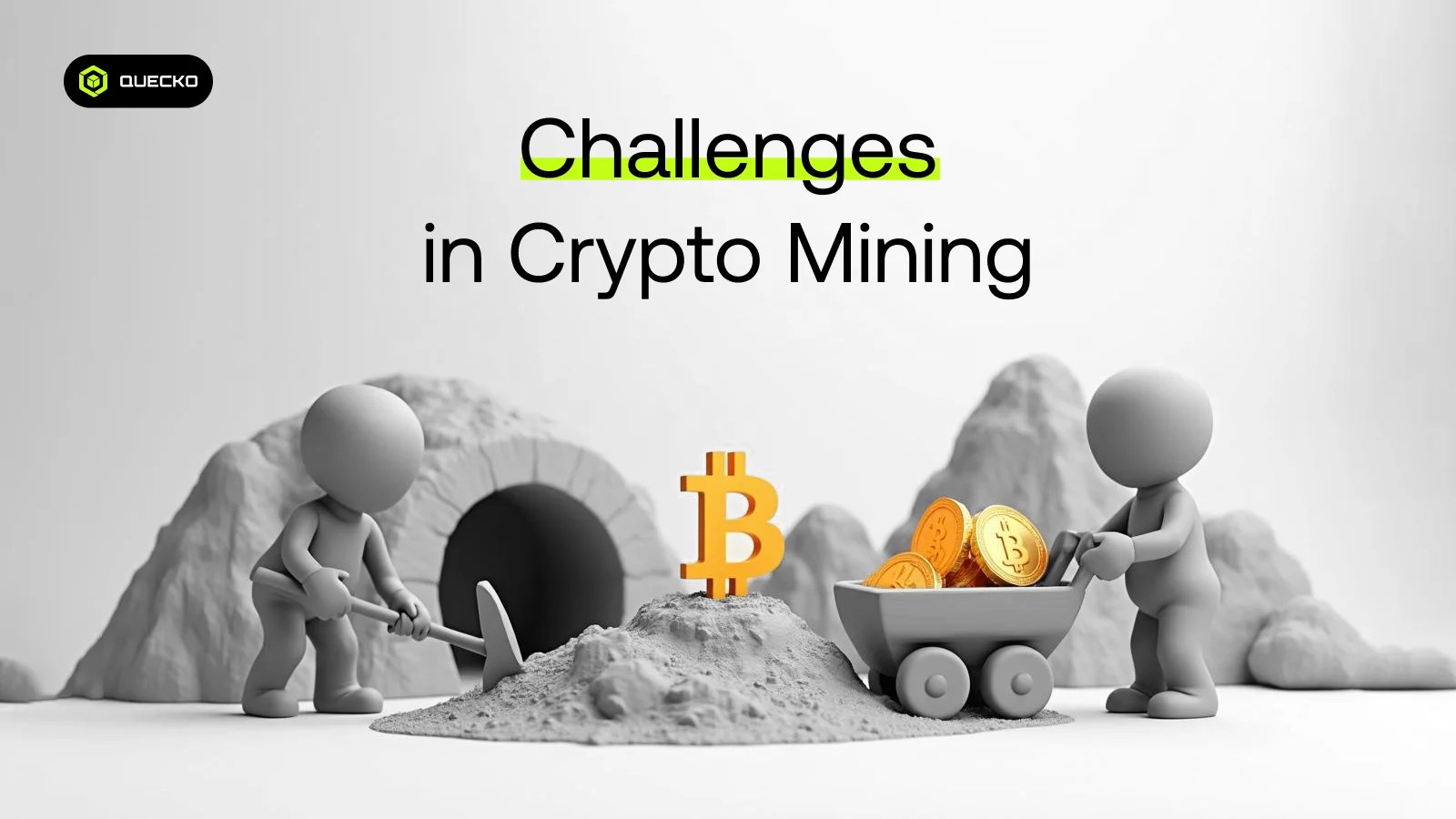Challenges in Crypto Mining
Explore the key challenges in crypto mining, including rising energy costs, regulatory hurdles, hardware limitations, and environmental concerns. Stay informed on the evolving landscape

Cryptocurrency mining has emerged as a pivotal component of the digital asset ecosystem, enabling the validation of transactions and the maintenance of decentralized networks like Bitcoin and Ethereum. By solving complex mathematical problems, miners contribute to the security and integrity of blockchain technology, earning rewards in the process. However, despite its potential for profit and technological innovation, crypto mining presents a myriad of challenges that can hinder its sustainability and scalability.
These challenges encompass a wide range of issues, including escalating energy consumption and environmental concerns, increasing hardware costs and technological obsolescence, regulatory uncertainties across different jurisdictions, and the growing difficulty of mining algorithms.
As the industry evolves, understanding these obstacles is crucial for miners, investors, and policymakers alike to navigate the intricate landscape of cryptocurrency mining effectively. This discussion delves into the multifaceted challenges faced by crypto miners today, highlighting the key hurdles and exploring potential avenues for overcoming them.
What is Crypto Mining?
Crypto mining, also known as cryptocurrency mining, is the process by which transactions are verified and added to a blockchain ledger, and new units of a cryptocurrency are created. It serves as the backbone of many digital currencies like Bitcoin, Ethereum, and others, ensuring the integrity, security, and decentralization of the network. Bitcoin mining, in particular, involves solving complex cryptographic problems to validate transactions and generate new bitcoins. Here’s a detailed breakdown of what crypto mining involves.
1. Verification of Transactions:
When users send cryptocurrencies to one another, these transactions are broadcast to the network. Miners collect these transactions into a pool called a “mempool” and select which ones to include in the next block.
2. Solving Cryptographic Puzzles:
Miners compete to solve complex mathematical problems associated with the block they are working on. This process involves hashing — applying cryptographic algorithms to generate a unique digital fingerprint of data. The goal is to find a hash that meets certain criteria (e.g., a specific number of leading zeros), which requires significant computational effort.
3. Proof of Work (PoW):
Most cryptocurrencies, like Bitcoin, employ a Proof of Work consensus mechanism. Miners repeatedly attempt different nonce values (random numbers) to produce a valid hash for the block. The first miner to find a valid hash broadcasts their solution to the network.
4. Validation and Addition to Blockchain:
Once a valid solution is found, other network participants verify its correctness. Upon consensus, the new block is added to the blockchain, permanently recording the transactions.
5. Reward Mechanism:
Miners are rewarded for their efforts with newly minted cryptocurrency units (block rewards) and sometimes transaction fees paid by users. This incentivizes miners to continue supporting the network.
6. Hardware and Energy Consumption:
Crypto mining requires specialized hardware such as Application-Specific Integrated Circuits (ASICs) or high-performance GPUs. The process consumes significant electrical power, leading to debates about environmental impact.
7. Difficulty Adjustment:
To maintain a consistent rate of block creation (e.g., approximately every 10 minutes for Bitcoin), the network adjusts the difficulty of cryptographic puzzles periodically based on the total computational power of the network.
In short, crypto mining, including Bitcoin mining, is a decentralized process that involves miners competing to solve cryptographic puzzles to verify transactions, secure the network, and generate new cryptocurrency units. It combines complex mathematics, specialized hardware, and significant energy expenditure to maintain the integrity and decentralization of digital currencies.
What are the difficulties in Crypto Mining?
Along with increasing challenges such as difficulty, high energy consumption, hardware obsolescence, and fluctuating prices of cryptocurrencies, as well as changing conditions in the world of Bitcoin mining, different implications have been coming into play regarding the questions on profitability, especially from the perspective of small miners competing against those with larger mining operations and very efficient mining facilities, which also lead to a possibly centralized mining power.”
Crypto mining needs much computational power. As algorithms get harder and network difficulty rises, miners are forced to buy new hardware to remain competitive: Bitcoin’s network difficulty adjusts roughly every two weeks, often going up, thus requiring stronger ASIC (Application-Specific Integrated Circuit) devices.
Increasing hardware requirements thus lead to:
- Rapidly obsolete equipment: Older miners become obsolete shortly after manufacture and purchase.
- High capital expenditures: Buying cutting-edge hardware is expensive.
- Limited access: Small miners find it hard to compete against large-scale setups.
b. Mining Difficulty and Network Congestion
Mining difficulty is a measure of how difficult it is to find a valid block. The more miners are added to the network, the tougher it gets to mine profitably, while when miners vacate the network, difficulty decreases. High difficulty will mean:
- Reduced profitability: The miners would be putting in many resources to obtain the same reward.
- Longer block times: It can potentially destabilize the network if calibrated poorly.
- Network congestion: An increased volume of transactions can also slow down the processing times so that the miners can lose revenue.
c. Hardware Limitations and Energy Consumption
Mining hardware, i.e., ASICs, GPUs, and CPUs, comes with physical limits regarding performance and energy efficiency. As much as hardware improves in power, it raises energy consumption, thus posing a sustainability concern.
- Heat generation: High-performance hardware ends up generating great heat and thus requires cooling solutions.
- HW lifespan: Overheating can lead to hardware’s decreased lifespan.
- Energy consumption: Large mining farms consume energy on par with those consumed by small countries, raising environmental issues.
d. Decentralization and Scalability
Since only entities with substantial capital can afford the newest hardware and energy costs, centralization may result from the growing difficulty and hardware demands. This calls into question the core tenet of cryptocurrency decentralization.
Financial Difficulties in Crypto Mining
Cryptocurrency mining is financially and operationally risky. Mining hardware can break down or be rendered obsolete too quickly, requiring long periods of downtime and costly repairs.
1 Electricity Cost: The primary operational expense in cryptocurrency mining is electricity consumption. Optimal locations are those with affordable, renewable energy sources.
- However:
- Fluctuating energy prices can turn mining profits into losses.
- Regulatory policies, including taxes or bans, may influence electricity costs based on regional legislation.
- Seasonal changes can cause variations in energy prices, impacting mining profitability.
- Depreciation and Hardware Costs: Purchasing mining equipment comes with hefty upfront expenses:Rapid depreciation: As new models appear; hardware rapidly loses value.
Problems with the supply chain: Hardware costs may rise due to shortages of semiconductors.
Maintenance costs: Hardware needs constant upgrades and repairs.
- Price fluctuations and market volatility: The price of cryptocurrencies fluctuates a lot. Price reductions can quickly reduce mining profitability, which can result in Miner shutdowns. During downturns, miners may stop working.Difficulty adjustments: Network difficulty may decrease as a result of downward price pressure.
Uncertainty in investments: Long-term planning is hampered by unpredictable returns.
- Mining Pools and Competition: Centralization may result from mining pools, where miners pool resources to increase their chances of receiving rewards. Networks are dominated by large pools, which raises concerns about:
51% attacks: When one party controls the majority of the hashing power. Decreased decentralization: Network trust is weakened by power concentration.
Environmental Difficulties in Crypto mining
Environmental Difficulties in Crypto mining, particularly for cryptocurrencies like Bitcoin, involves the process of validating transactions and adding them to the blockchain through computationally intensive procedures known as proof-of-work. While this process underpins the security and decentralization of many digital currencies, it also presents significant environmental challenges.
High Energy Consumption and Electricity Consumption
One of the most prominent environmental concerns associated with crypto mining is its substantial energy consumption. Mining operations often utilize large-scale data centers equipped with high-performance hardware such as ASICs (application-specific integrated circuits) or GPUs (graphics processing units). These mining equipment and mining rigs require continuous operation, consuming vast amounts of electricity, sometimes comparable to the energy usage of entire countries. For example, estimates have suggested that Bitcoin mining alone consumes more electricity than some small nations, raising alarms about its sustainability.
Carbon Footprint and Fossil Fuel Dependency
The environmental impact is further compounded by the energy sources powering blockchain networks in mining farms. In regions where electricity generation relies heavily on fossil fuels—such as coal or natural gas—the carbon footprint of Bitcoin mining activities increases significantly. This reliance exacerbates greenhouse gas emissions, contributing to climate change. Conversely, in areas utilizing renewable energy, the environmental impact is comparatively lower, but such regions are often limited in number.
E-waste and Hardware Lifecycle
Crypto mining equipment tends to have a relatively short lifespan due to rapid technological advancements and the intense wear from continuous operation. As a result, large quantities of electronic waste (e-waste) are generated when outdated or inefficient hardware is discarded. Improper disposal of mining rigs and other hardware components can lead to environmental contamination from toxic materials found in electronic components.
Localized Environmental Degradation
Mining farms can also lead to localized environmental issues, such as water usage and land degradation. Large-scale operations may require significant water resources for cooling systems, impacting local water supplies. Additionally, the physical infrastructure and noise generated by mining facilities can disturb local ecosystems and communities.
Regulatory and Ethical Challenges
The environmental difficulties associated with crypto mining have prompted regulatory responses in various jurisdictions, aiming to curb energy-intensive practices. Ethical debates also revolve around whether the environmental costs justify the benefits of decentralized digital currencies, especially given the urgent need to reduce global greenhouse gas emissions.
Overall, the environmental difficulties in crypto mining encompass high energy consumption, reliance on fossil fuels leading to high carbon emissions, e-waste, local environmental degradation, and socio-economic impacts. Addressing these challenges requires concerted efforts towards utilizing renewable energy sources, improving hardware efficiency, and establishing sustainable practices within the industry.
Legal and Regulatory Difficulties in Crypto Mining
Crypto mining, the process of validating blockchain transactions and securing the network through computational work, faces a complex and evolving landscape of legal and regulatory challenges across different jurisdictions. These difficulties stem from the decentralized and often borderless nature of cryptocurrencies, combined with varying national policies toward digital assets. Regulatory Uncertainty and Lack of Clear Frameworks Many countries lack comprehensive regulations specifically tailored to cryptocurrency mining.
This creates uncertainty for miners regarding legal compliance, taxation, and operational legitimacy. In some cases, existing financial or energy laws are ambiguously applied to mining activities, leaving miners unsure of their legal standing. Bans and Restrictions Several nations have imposed outright bans or severe restrictions on crypto mining due to concerns over energy consumption, environmental impact, or perceived illicit uses.
For example, China historically imposed a nationwide ban on cryptocurrency mining, citing environmental issues and financial risks. Such bans can lead to the shutdown of mining operations, legal penalties, and loss of investments. Energy Regulations and Environmental Laws Crypto mining is energy-intensive, often requiring substantial electricity consumption. Governments concerned with environmental sustainability and energy security may impose regulations, taxes, or restrictions on mining operations. Some countries have introduced carbon taxes or limited the use of certain energy sources, complicating the operation of mining farms and raising compliance issues.
Taxation Issues Tax authorities worldwide differ in their treatment of crypto mining income. Some consider mining profits as taxable income, requiring detailed reporting and tax payments, while others lack clear guidance. Additionally, regulations around data privacy and security can impact how mining operations are structured and operated. Cross-Border Legal Challenges Given the international nature of cryptocurrencies, miners operating across borders face complex legal challenges, including differing regulations, export controls, and sanctions. Jurisdictional conflicts can complicate legal compliance and expose miners to legal risks in multiple countries.
In short, legal and regulatory difficulties in crypto mining encompass a broad range of issues, including uncertain legal status, bans, energy and environmental regulations, taxation, cross-border jurisdictional conflicts, and enforcement risks. Navigating this landscape demands careful legal analysis, compliance strategies, and ongoing monitoring of regulatory developments to operate sustainably and legally in the cryptocurrency ecosystem.
Security Difficulties in Crypto Mining
Crypto mining, the process of validating transactions and adding them to a blockchain, is integral to maintaining decentralized cryptocurrencies like Bitcoin and Ethereum. However, the process presents a range of security challenges that can threaten the integrity, profitability, and operational stability of mining operations. These difficulties stem from both technological vulnerabilities and malicious actors seeking to exploit the system.
Cyber Attacks and Malware: Mining hardware and associated software are prime targets for cybercriminals. Attackers often deploy malware designed to hijack mining resources (cryptojacking), steal private keys, or disrupt operations. Such malware can lead to financial losses, compromised data, and reduced mining efficiency. Notably, mining pools and exchanges are high-value targets for hacking attempts, which can result in significant theft of cryptocurrencies.
51% Attacks: A 51% attack occurs when a single entity or a colluding group gains majority control over the network’s hashing power. This majority allows them to manipulate transactions, double-spend coins, or censor specific transactions. While more feasible in smaller or less-secure networks, the threat remains significant, especially for emerging or less decentralized cryptocurrencies.
Network Security Risks: Mining operations rely heavily on internet connectivity. Distributed denial-of-service (DDoS) attacks can disrupt network communications, leading to downtime or delayed block validation. Furthermore, insecure network configurations may allow attackers to intercept or manipulate data exchanged between miners and pools.
Regulatory and Legal Risks: Changes in legal frameworks or government crackdowns can impact the security and operation of mining farms. Sudden legislation or bans can lead to shutdowns, confiscation of hardware, or legal action, which pose risks to the security of ongoing operations.
Prospects for the Future and Possible Remedies
The future prospects of any domain—be it environmental sustainability, technological development, social progress, or economic stability—are shaped by current trends, emerging challenges, and the effectiveness of proposed remedies. While certain issues may seem daunting today, proactive strategies and innovative solutions hold the promise of positive transformation.
Future Prospects:
1.Technological Advancements: Rapid progress in areas such as artificial intelligence, renewable energy, biotechnology, and information technology offers opportunities for enhanced efficiency, improved quality of life, and sustainable development. For instance, advancements in renewable energy could significantly reduce reliance on fossil fuels, mitigating climate change.
2.Global Collaboration: Increasing international cooperation through treaties, organizations, and shared research fosters collective efforts to address global issues like pandemics, environmental degradation, and economic disparities. Such collaborations can expedite solutions and ensure equitable progress.
- Awareness and Education: Growing awareness about issues such as climate change, social justice, and health empowers individuals and communities to advocate for change. Education initiatives can cultivate responsible citizenship and innovation-driven thinking.
- Policy and Governance: Progressive policies focused on sustainability, social equity, and technological regulation can steer development in beneficial directions, ensuring that future growth aligns with ethical and ecological considerations.
Possible Remedies:
- Sustainable Practices: Implementing eco-friendly practices in industries, agriculture, and urban planning can help preserve natural resources and reduce pollution. Promoting circular economies and renewable energy adoption are key strategies.
- Legislative Measures: Enacting and enforcing laws that protect the environment, uphold human rights, and regulate emerging technologies are vital. Strong legal frameworks can prevent exploitation and ensure accountability.
- Research and Innovation: Investing in research for cleaner technologies, medical breakthroughs, and social solutions can address root causes of problems and create resilient systems for the future.
- Community Engagement: Grassroots movements and community-led initiatives can foster local solutions tailored to specific needs, enhancing resilience and social cohesion.
- Education and Awareness Campaigns: Promoting widespread understanding of critical issues through education can motivate behavioral change and build a culture of responsibility.
- International Cooperation: Global efforts, including climate accords and health initiatives, are essential in tackling issues that transcend borders. Sharing knowledge, resources, and technology can accelerate progress.
While challenges remain, the prospects for the future are optimistic if current trends are harnessed effectively through strategic remedies. Emphasizing innovation, collaboration, and sustainable practices can pave the way for a resilient, equitable, and sustainable future.
Conclusion
The challenges of crypto mining encompass a multifaceted array of technical, environmental, economic, and regulatory issues that collectively influence the sustainability and viability of the industry. Technically, the rapid escalation in computational difficulty necessitates substantial investment in specialized hardware and energy resources, often leading to increased operational costs and barriers to entry for new participants.
Environmentally, the significant energy consumption associated with mining activities raises concerns over carbon footprints and ecological impact, prompting calls for more sustainable practices and the adoption of renewable energy sources. Economically, market volatility and fluctuating cryptocurrency prices can undermine profitability, making mining a high-risk endeavor susceptible to financial instability. Regulatory challenges further complicate the landscape, as evolving legal frameworks and government policies vary globally, potentially imposing restrictions or bans that disrupt operations and influence market dynamics.
Collectively, these challenges highlight the need for innovation, responsible resource management, and adaptive regulatory approaches to ensure the long-term growth and sustainability of crypto mining. Addressing these issues is crucial for balancing technological advancement with environmental stewardship and economic stability, paving the way for a more resilient and responsible blockchain ecosystem.
Date
3 months agoShare on
Related Blogs

How Blockchain Is Disrupting Traditional Banking Systems
10 days ago

AI-Powered Smart Contract Wallets The Future of User-Friendly Blockchain UX
15 days ago

Using NFTs for Brand Loyalty: The Next Big Marketing Shift
16 days ago

How Tokenized Real-World Assets Are Reshaping Finance in 2025
17 days ago







